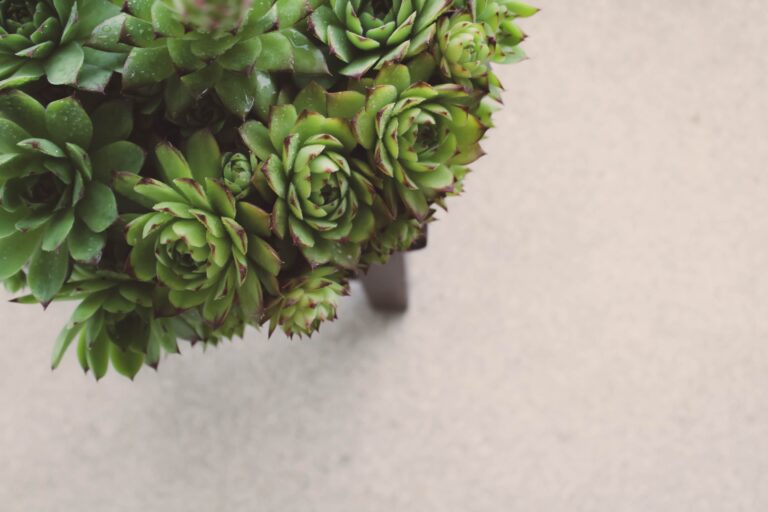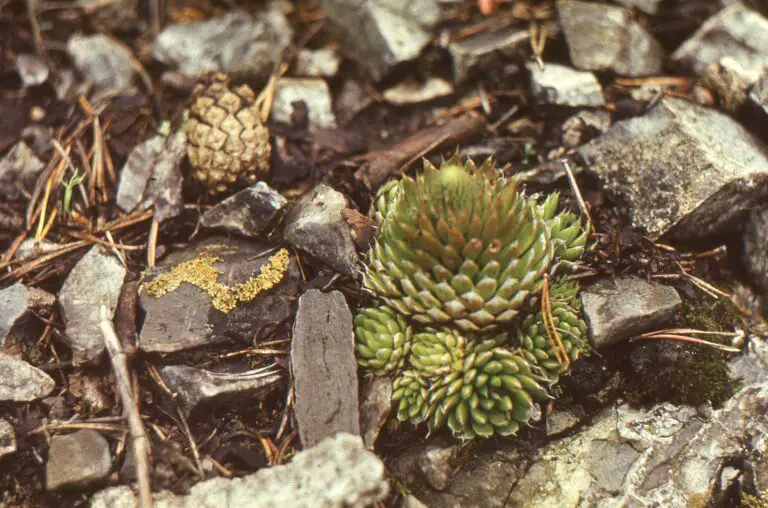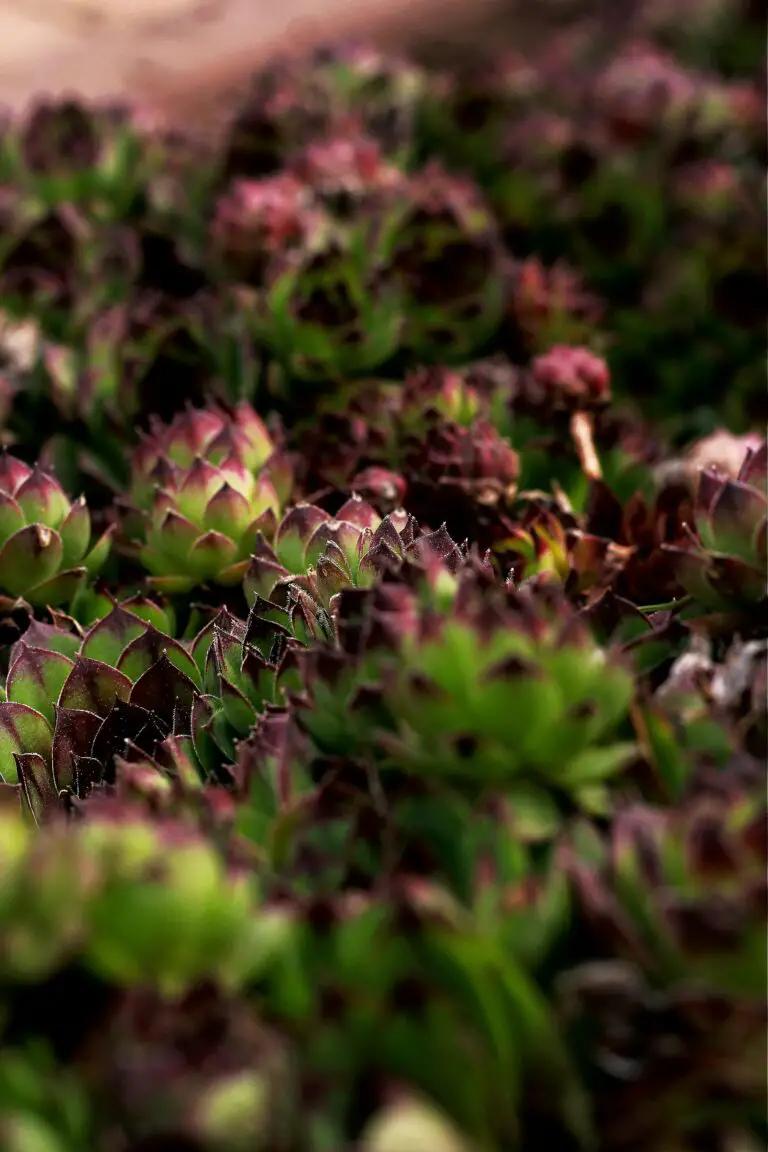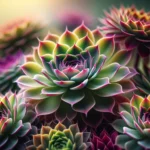Understanding Sempervivum Etiolation
Imagine your delightful sempervivum, commonly known as ‘hens and chicks,’ stretching out like a cat in the sun, seeking that warm beam of light. But instead of a content feline, you have a leggy succulent, a phenomenon we call etiolation. This is nature’s way of telling you that your succulent is on a quest for more sunlight and is not quite hitting the mark.
At its core, etiolation is a survival mechanism. It occurs when a plant, such as our beloved sempervivum, doesn’t receive sufficient light and thus starts to grow taller and thinner, reaching out desperately for a light source. In the succulent world, adequate lighting isn’t just a luxury; it’s a necessity. Picture your sempervivum in its natural habitat, basking in the glory of the unfiltered sun. Now compare that to its new home on your shaded windowsill or the dimly lit corner of your patio.
Why Sempervivums Stretch: A Light Dilemma
The struggle of indoor sempervivums is all too real when battling against etiolation. These hardy plants that once sprawled across rocky terrains are now grappling with the limited lumens of artificial lighting or the inconsistent rays peeking through the window. But remember, inadequate lighting is not just about intensity, it’s also about duration. A sempervivum might be sitting pretty in a sunny spot but if the sun’s visit is as short as a commercial break, your plant will likely start to stretch.
Imagine hosting a dinner party with a table set for a feast, yet the food served is barely enough to fill an appetizer plate. That’s how your sempervivum feels when it doesn’t get its fill of sunlight. Indoor lighting might mimic the look of sunshine, but for a sempervivum, it’s often just crumbs from the table of true, life-giving daylight.
Etiolation doesn’t happen overnight. It’s a gradual process, a slow dance played out over weeks and months of insufficient exposure to that golden orb in the sky. You’ll notice your sempervivum reaching for the stars, quite literally, as it grows taller and spindlier, its leaves spaced out like lonely footsteps in the snow. But fret not, for understanding this peculiar process is your first step toward remedying it and restoring your sempervivum to its plump and perky self.
In the end, even the toughest succulents show us that they have needs too, especially when it comes to their irreplaceable friend, the sun. A sempervivum’s quest for light is a poignant reminder of the intricate dance between plants and their environment, a dance that, with the right steps, can lead to a flourishing and vibrant life.
Identifying Etiolated Sempervivum
Have you ever noticed your once compact and vibrant Sempervivum starting to look a bit lanky and lackluster? It’s a common storyline for these hardy succulents to face, known as etiolation. Etiolation is the stretching of plants, which occurs when they are reaching for more light. This phenomenon is like a silent cry for help, saying, “I need more sun, please!”

Spotting the early signs of etiolation in your Sempervivum is crucial, and it’s not just about aesthetics—though that’s part of it. Typically, you’ll notice the stems getting longer with more space between leaves, which would normally be compact. Leaves may also appear paler than usual, showing they aren’t synthesizing enough chlorophyll. It’s a case of your green-thumb intuition telling you that something’s off. Visual aids, like comparative photos you might find here, can be incredibly helpful in catching these changes early on.
Let’s illustrate it with an example: Imagine a regular Sempervivum, robust and dense, like a mini green rosette. Now think of it slowly stretching upwards, leaves spaced out, desperate for more sunlight—this stretched form is what etiolated Sempervivum looks like. But fear not! With the right care and adjustments, they can return to their former tight-knit glory. Keeping a watchful eye for these signs is the first step to preventing leggy outcomes for your cherished succulents.
The Light Necessity: Sempervivum’s Photosynthesis Process
Imagine, if you will, a world where the lush green tapestry of plants performs a daily solar-powered symphony. Central to this performance is the sempervivum, a plucky succulent known for its resilience and geometric beauty. Now, let’s shed some light on an issue that could dim the brilliance of these hardy performers—etiolation. In this section, we’ll explore the significance of light, not just for showmanship, but for the very breath of sempervivum’s life.

The act of photosynthesis is kind of like a plant’s day job. Sunlight is the boss, and the sempervivum—you could say—is an employee that thrives under strong leadership. Without adequate sunlight, our little green operative can’t perform efficiently. Etiolation becomes its cry for help, a clear sign that it’s struggling to catch those precious sun rays. Indeed, adequate sunlight is the fuel that powers the photosynthesis machine, allowing sempervivums to transform light into life-giving sugars. It’s nothing short of miraculous!
But here’s the rub: sempervivums need a very specific dose of this radiant energy. Too little, and they stretch towards the sky, etiolating in a desperate bid for more light. It’s a risky gamble that can lead to leggy, weak succulents prone to toppling over. On the flip side, with just the right amount of sun-soaked delight, these plants can bask in the glow of optimal health. Photosynthesis purrs along like a well-oiled engine, churning out sugars and perpetuating growth, which is the sign of a truly content sempervivum. For more comprehensive insights into succulent care, be sure to explore our well-curated guide.
Incorporating real-life examples, imagine the sempervivum as your skin; it needs the sun’s kiss to flourish but not so much that it withers. Similarly, sempervivums, with their symmetrical rosettes, are the epitome of nature’s balance—where even the sun’s embrace must be just enough.
So, as we ponder on the light necessity for sempervivum’s photosynthesis process, let’s strive to position these stoic guardians of the plant kingdom in that sweet spot of sunshine. Giving them their Goldilocks dose of light is not just about avoiding etiolation—it’s about celebrating the magic of photosynthesis and ensuring the longevity of these verdant wonders.
Strategic Succulent Positioning and Lighting Solutions
So, you’ve got a sempervivum, and it’s starting to stretch out like it’s practicing morning yoga – quite the sight, but not what you’re going for with your structured succulent display. This phenomenon, my friends, is known as etiolation, and it’s a common challenge for succulent enthusiasts. But fear not! We have the ultimate guide to ensure your sempervivums get just the right amount of solar love, so they can stay compact, colorful, and Instagram-worthy.

Imagine a sempervivum rosette, perfectly symmetrical, basking in the gentle morning sunbeams on your windowsill. Picture-perfect, right? The key here is ‘gentle.’ These hardy little plants love sunlight but in doses that mimic their native alpine homes. Too much direct light, and they’ll sunburn faster than you on a Caribbean beach without sunscreen. Too little, and they’ll stretch out, reaching for sunlight like a kid on tiptoes at a candy store.
Tips for Perfect Plant Placement
Let’s break it down with some real-life advice: south-facing windows are a sempervivum’s best friend. They offer the golden rays that these plants crave without the risk of a mid-afternoon scorch. If you’re in the Northern Hemisphere, that is. For our friends down under, north-facing it is! But life isn’t always perfectly directional, is it? Fear not, there’s a workaround: sheer curtains. They diffuse the light, spreading it like butter across your succulents’ leaves, offering full coverage without the intensity.
If natural light is as scarce as a rain in the Sahara, artificial grow lights can be your saving grace. LED or fluorescent lights designed for plants will thread the needle between too much and too little light, helping prevent your sempervivums from doing their stretch routine. Place them a few inches above your plants, and they’ll reward you by staying as squat as a professional squatter.
Remember, positioning is everything. You can read more about this in our comprehensive guide on succulent care tips. By taking a page out of Goldilocks’ book, your sempervivums will look ‘just right’, compact and colorful, without that unwanted leggy stretch. Discover the joy of healthy, etiolation-free sempervivums, and let the bragging (and blooming) begin!
Reviving Your Leggy Sempervivum
Is your Sempervivum starting to stretch out toward the light, its formerly compact shape turning into a leggy silhouette? This condition, known as etiolation, might have you worried, but fear not! With a little know-how and some elbow grease, you can bring your stretched succulent back from the brink. Let’s get your Sempervivum sitting tall, just the way nature intended!
Snip and Tuck: Pruning Back to Perfection
First things first, it’s time to give your plant a haircut. Grab some clean, sharp shears and trim away the elongated parts of the Sempervivum. Now, hold on! Before you get snip-happy, remember that the goal is to encourage new, healthy growth, not to give your plant a buzzcut. Cut just above a leaf node, where you can see tiny new leaves are ready to burst forth. This will signal the plant to branch out and get back to its naturally compact form.
Pruning isn’t just about aesthetics; it’s a way to tell your plant, “Hey, let’s focus on growing denser, not taller.” As you prune, think of each cut as a friendly nudge in the right direction. And don’t toss those cuttings! They’re perfect for propagation—a real-life example of waste not, want not.
Light: Guiding the Way to Upstanding Growth
Light is like a lighthouse for your Sempervivum, guiding its growth upward and making sure it doesn’t stray into the etiolated zone. Ensuring your green buddy gets enough sunshine is crucial. It’s a common tale: A once vibrant succulent, tucked away in a dark corner of the home, starts stretching out in a desperate search for light. Place your Sempervivum near a bright window where it can soak up at least six hours of indirect sunlight a day, and watch it regain its confidence.
Long-Term Strategies: Preventing Future Legginess
Now that you’ve pruned your plant and positioned it in the perfect sunny spot, let’s talk long-term tactics. Think of this as the training regime for your Sempervivum—consistent care that keeps it fit and fabulous. Ensuring adequate lighting is step one, but don’t overlook the importance of the right soil mix, regular watering, and food fit for a king. Just like us, plants need a balanced diet to stay healthy. A well-draining soil mix prevents root rot, while a succulent-specific fertilizer gives your Sempervivum the nutrients it craves.
Etched into the memory of every succulent enthusiast is the time when their preciously pampered Sempervivum fell victim to stretching. Yet, with these remedial and preventive measures, you’ll write a new history—a saga of triumph over the leggy challenge. Practice these strategies, and you’ll be the proud champion of a Sempervivum squad standing strong and sturdy!
Preventive Measures Against Etiolation
When it comes to keeping your sempervivum happy and compact, prevention is the name of the game. Etiolation, or the stretching of plants due to inadequate light, can turn your tight, symmetrical succulents into leggy, off-kilter oddballs. But fear not, plant pals! There’s a smorgasbord of tips to keep your hens and chicks as perky as they ought to be.
Potting: The Root of Success
Imagine this: your precious sempervivum is all dressed up with nowhere to go. Root confinement in a too-small pot can be like a restrictive outfit, cramping your plant’s style. So, let’s talk ideal potting scenarios! A well-sized container allows for a comfortable fit—cozy but with room to grow. And let’s not forget drainage. Elevate your potting game with a mix that ushers away excess water like a bouncer at a VIP party, and you’ve set the stage for a standing ovation from your green audience.
Watering: The Balancing Act
Now, on to hydration. Overwatering your succulents is like giving them an unlimited soda pass—they’ll drink up but won’t necessarily feel great afterward. The key is to mimic a desert downpour followed by a dry spell. Quench their thirst thoroughly, then step back. Let the soil dry completely before you bring on the next rain. That’s the kind of rhythm that keeps sempervivum from reaching for the stars—literally.
Fertilization: Less is More
Last but not least, let’s sprinkle in some wisdom about fertilization. Sempervivum isn’t greedy; a modest amount of nutrients will do. Overindulging them is like feeding a toddler sugar before bedtime—you’ll get a burst of unwelcome energy, or in this case, unwieldy growth. Stick to a light feed a couple of times during the growing season, and your sempervivums will reward you by staying down to earth.
To wrap our minds around these tips, let’s dive into a visual guide that beautifully showcases how to keep our succulent friends from stretching out. Here’s a video to turn the knowledge we’ve discussed into action:
Now, armed with potting prowess, a watering wand, and a sprinkle of fertilization finesse, you’re on your way to growing sempervivums that are more top models than beanstalk climbers. Keep these best practices close, and watch your sempervivum stand tall—while staying short, of course!
Myths and Misconceptions About Etiolated Succulents
Let’s shine a ray of truth onto the shadowy realm of myths surrounding etiolated sempervivums – those peculiar, elongated succulents that both bewitch and befuddle plant enthusiasts. Etiolation, or the stretching of plants towards light, is like a whisper-down-the-lane game in the gardening world: full of misinformation and tall tales. Today, we straighten out the bent truths to keep your sempervivums standing tall – metaphorically, of course!

Succulents Stretching the Truth
You’ve likely heard the classic folktale: ‘An etiolated sempervivum is damaged beyond repair.’ Not so fast. While stretching is a sign of insufficient light, it doesn’t mark the end of your plant’s journey. With proper intervention and a sunny spot, your sempervivum can still flourish. Think of it as a cry for help, not a death sentence.
Leggy Legends
Another legend whispers that these stretchy succulents need to be tossed out and replaced with shorter, stockier comrades. Instead of relegating your etiolated sempervivums to the compost pile, consider them living sculptures, evocative of their struggle and resilience. With a trim and some TLC, you can propagate new growth and watch your verdant phoenix rise from the leaves.
Stretching ≠ Failing
Who started the rumor that a stretching sempervivum is a failure? In nature, stretching is a strategic maneuver towards the light – a testament to the plant’s tenacity. Under your watchful care, an etiolated succulent is simply taking the scenic route to success. By understanding and empathizing with your plant’s phototropic pursuits, you can guide it back to its compact glory.
Etiolated sempervivums simply tell a story – one of adaptation and the relentless quest for sunlight. It’s a tale not of flaws but of a willingness to go the extra inch (or several) for survival. With this newfound knowledge, you’re well-equipped to rewrite the narrative and nurture your leggy sempervivums back to stout health.
FAQs on Sempervivum Etiolation
Got a case of leggy Hens and Chicks? You’re not alone! Sempervivum etiolation has baffled many succulent enthusiasts. But fear not! I’m here to demystify this elongating enigma with some real-life questions from people like you, aiming for robust, well-rounded succulents.
Why Do My Sempervivums Get Leggy?
It’s like they’re reaching for the sky, isn’t it? Your sempervivums stretch out when they’re not soaking up enough sunlight. They’re literally growing taller in a quest to catch those bright rays. Imagine sunbathers on a crowded beach, standing up to get over the shadows — your sempervivums are doing just that!
How Can I Prevent My Succulents from Getting Etiolated?
It’s all about location, location, location! Keep your green buddies in a spot where they can bask in the sunlight — think of it as their personal spa retreat. A south-facing window or a happy corner on the patio where the sunlight is a regular guest could do wonders!
Can Etiolated Sempervivums Return to Normal?
Think of etiolation as a bad haircut; you can’t make the hair go back, but you can certainly style it out. Similarly, once your sempervivum stretches, it won’t shrink back, but you can propagate the plant to start fresh. It’s like hitting the reset button for a lusher, compact look!
What Should I Do with the Stretched Out Parts?
Don’t fret over the stretched segments; turn a challenge into an opportunity! Use those leggy pieces for propagation. Snip them off, let them callous, and replant. Before you know it, you might have a whole new brood of sempervivums sprouting up like a mini succulent army. And that’s a win!
Does Etiolation Affect the Health of My Sempervivum?
While your sempervivum playing ‘stretch Armstrong’ isn’t ideal, it’s not spelling doom for their health. As long as you address the light issue and give them the care they crave, they’ll soldier on. Just remember, light is to sempervivums what coffee is to us — utterly essential!
We’ve tackled the twist and turns of sempervivum etiolation, but don’t let it curve your enthusiasm for these resilient rosettes. With a bit of sun, some snipping, and a whole lot of love, your sempervivums will be strutting their stuff as plump, happy campers in no time!



